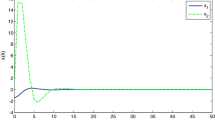Abstract
In this paper, strictly positive real control for singularly perturbed systems in (semi)finite frequency ranges is studied. For the general linear systems, necessary and sufficient conditions for the existence of a stabilizing state feedback controller are given based on the generalized KYP lemma, and use the results to study singularly perturbed systems, a composite state feedback controller is constructed, which preserves the stability and positive real property.
Similar content being viewed by others
References
D. W. Luse and J. A. Ball, “Frequency-scale decomposition of H ∞ disk problems,” SIAM Journal of Control and Optimization. vol. 27, pp. 814–835, 1989.
H. M. Oloomi and M. E. Sawan, “Suboptimal model-matching problem for two frequency scale transfer functions,” Proc. of American Control Conf., pp. 2190–2191, 1989.
H. K. Khalil and F. C. Chen, “H ∞ control of two-time-scale systems,” System & Control Letter, vol. 19, pp. 35–42, 1992.
Z. Pan and T. Basar, “H ∞ optimal control for singularly perturbed systems part I: perfect state measurements,” Automatica, vol. 29, pp. 401–423, 1993.
Z. Pan and T. Basar, “H ∞ optimal control for singularly perturbed systems part II: perfect state measurements,” IEEE Trans. on Automatic Control, vol. 39, pp. 280–300, 1994.
E. Fridman, “Near-optimal H ∞ control of linear singularly perturbed systems,” IEEE Trans. on Automatic Control, vol. 41, no. 2, pp. 236–240, 1996.
D. W. Luse and H. K. Khalil, “Frequency domain results for systems with slow and fast dynamics,” IEEE Trans. on Automatic Control, vol. AC-30, pp. 1171–1179, December 1985.
J. C. Willems, “Least squares stationary optimal control and the algebraic Riccati equation,” IEEE Trans. on Automatic Control, vol. AC-16, no. 6, pp. 621–634, December 1971.
A. Rantzer, “On the Kalman-Yakubovich-Popov lemma,” System & Control Letter, vol. 28, no. 1, pp. 7–10, 1996.
T. Iwasaki and S. Hara, “Robust control synthesis with general frequency domain specifications: static gain feedback case,” Proc. of American Control Conf., pp. 4613–4618, 2004.
T. Iwasaki, S. Hara, and A. L. Fradkov, “Time domain interpretations of frequency domain inequalities on (semi) finite ranges,” System & Control Letter, vol. 54, pp. 681–691, 2005.
T. Iwasaki and S. Hara, “Generalized KYP lemma: unified frequency domain inequalities with design applications,” IEEE Trans. on Automatic Control, vol. Ac-50, pp. 41–59, 2005.
S. Hara and T. Iwasaki, “Robust PID control using generalized KYP synthesis,” IEEE Control systems magazine, pp. 80–91, 2006.
W. Sun, P. P. Khargonekar, and D. Shim, “Solution to the positive real control problem for linear time-invariant systems,” IEEE Trans. on Automatic Control, vol. 39, pp. 2034–2046, 1994.
T. Iwasaki and S. Hara, “Dynamical system design from a control perspective: finite frequency positive-realness approach,” IEEE Trans. on Automatic Control, vol. 48, no. 8, pp. 1337–1354, 2003.
P. Mei, C. X. Cai, and Y. Zou, “Finite frequency positive real control of singularly perturbed systems,” Proc. of the 2nd International Symposium on Systems and Control in Aeronautics and Astronautics, pp. 1–5, 2008.
P. Mei, C. X. Cai, and Y. Zou, “A generalized KYP lemma-based approach for H-infinity control of singularly perturbed systems,” Circuits Systems and Signal Process, vol. 28, no. 6, pp. 945–957, 2009.
Z. Gajic, M. T. Lim, and M. Dekker, “Optimal control of singularly perturbed linear systems and applications,” Automatica, vol. 39, pp. 367–376, 2003.
T. Iwasaki and S. Hara, “Feedback control synthesis of multiple frequency domain specifications via generalized KYP lemma,” International Journal of Robust and Nonlinear Control, vol. 17, pp. 415–434, 2007.
R. E. Skelton, T. Iwasaki, and K. M. Grigoriadis, A Unified Algebraic Approach to Linear Control Design, Taylor & Francis, 1997.
D. Henrion and G. Meinsma, “Rank-one LMIs and Lyapunov’s inequality,” IEEE Trans. on Automatic Control, vol. 46, no. 8, pp. 1285–1288, 2001.
K. K. Xu, The Singularly Perturbation in Control System, Science Press, Beijing, 1986.
H. K. Khalil, “Output feedback control of linear two time scale systems,” IEEE Trans. on Automatic Control, vol. 32, pp. 784–792, 1987.
Author information
Authors and Affiliations
Corresponding author
Additional information
Recommended by Editor Young Il Lee. This work was supported by the National Natural Science Foundation of China under Grant No.60784007 and National Science Foundation for Distinguished Young Scholars of P.R China under Grant 60625303 and Specialized Research Fund for the Doctoral Program of Higher Education under Grant Nos.20070288055 and 200802880024.
Yanlong Huang received his B.S. and M.S. degrees in Automatic Control from Nanjing University of Science and Technology, Nanjing, China, in 2008 and 2010, respectively. He is working toward a Ph.D. degree with the Laboratory of Complex Systems and Intelligence Science, Institute of Automation, Chinese Academy of Sciences, Beijing, China. His research interests include control, robotics, and automation.
Chenxiao Cai received her Ph.D. degree in Control Theory and Control Engineering from Automatic School of Nanjing University of Science and Technology in 2004. Now she is an associate professor at automatic school of Nanjing University of Science and Technology. Her research interests cover analysis and synthesis about singularly perturbed system and so on.
Yun Zou received his B.S. degree from Northwestern University, China, in 1983, majored in Numerical Mathematics, and his Ph.D. degree from Nanjing University of Science and Technology, China, in 1990, majored in Automatic Control. He is now a professor of the Department of Automation in Nanjing University of Science and Technology, and a mathematical reviewer of Mathematical Reviews. His research interests include singular systems, 2-D systems, nonlinear systems and power systems.
Rights and permissions
About this article
Cite this article
Huang, Y., Cai, C. & Zou, Y. Finite frequency positive real control for singularly perturbed systems. Int. J. Control Autom. Syst. 9, 376–383 (2011). https://doi.org/10.1007/s12555-011-0220-5
Received:
Revised:
Accepted:
Published:
Issue Date:
DOI: https://doi.org/10.1007/s12555-011-0220-5



